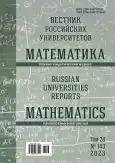The coefficient problem for bounded functions and its applications
- Authors: Stupin D.L.1
-
Affiliations:
- Tver State University
- Issue: Vol 28, No 143 (2023)
- Pages: 277-297
- Section: Original articles
- URL: https://journal-vniispk.ru/2686-9667/article/view/296412
- DOI: https://doi.org/10.20310/2686-9667-2023-28-143-277-297
- ID: 296412
Cite item
Full Text
Abstract
A review of the solution of the classical coefficient problem on the class $\Omega_0$ of bounded in the unit disc functions $\omega$ with normalization $\omega(0)=0,$ going back to I. Schur, is given. Then the first six inequalities, describing respectively the first six coefficient bodies on the class $\Omega_0,$ are derived. Next, a method of obtaining similar inequalities for classes $M_F$ of functions subordinated to the holomorphic function $F,$ giving the solution of the coefficient problem for these classes, is given. Then the properties of the mentioned inequalities as well as the relations between them are analyzed. In addition, it is shown that only one $n$-th inequality is sufficient to describe the $n$-th body of coefficients on the class $\Omega_0,$ and hence on $M_F.$
The problems of estimating both the modulus of each initial Taylor coefficient individually and estimating modules of all Taylor coefficients at once are discussed.
The problem of obtaining the sharp estimates of the modulus of the Taylor coefficient with number $n,$ i.e. the functional $|\{f\}_n|,$ on the class $M_F$ is at first reduced to the problem of estimating the functional over the class $\Omega_0,$ which in turn is reduced to the problem of finding the maximal modulo of conditional extremum of a real-valued function of $2(n-1)$ real arguments with constraints of inequality type $0 \leqslant x_k \leqslant1,$ $0\leqslant\varphi_k<2\pi,$ which allows us to apply standard methods of differential calculus to study for extrema, since the target function is infinitely smooth in all of its arguments. For this purpose, the results of the solution of the classical coefficient problem on the class $\Omega_0$ are used.
About the authors
Denis L. Stupin
Tver State University
Author for correspondence.
Email: dstupin@mail.ru
ORCID iD: 0000-0002-9183-9543
Candidate of Physics and Mathematics, Associate Professor of the Mathematical Analysis Department
Russian Federation, 33 Zhelyabova St., Tver 170100, Russian FederationReferences
- G.M. Golusin, Geometric Theory of Functions of a Complex Variable, I, II, Amer. Math. Soc., 1969.
- I. Schur, “Über potenzreihen, die in Innern des Einheitskrises Beschränkt Sind”, Reine Angew. Math., 147 (1917), 205–232.
- C. Carathéodory, “Über den Variabilitätsbereich der Koeffizienten von Potenzreihen, die gegebene Werte nicht annehmen”, Mathematische Annalen, 64 (1907), 95–115.
- C. Carathéodory, “Über die Variabilitätsbereich des Fourierschen Konstanten von Positiv Harmonischen Funktion”, Rendiconti Circ. Mat. di Palermo, 32 (1911), 193–217.
- D.L. Stupin, “The problem of coefficients for functions mapping a circle into a generalized circle and the Caratheodory–Feuer problem”, Application of Functional Analysis in Approximation Theory, Tver State University Publishing House, Tver, 2012, 45–74 (In Russian).
- R.A. Kortram, “A simple proof for schur’s theorem”, Proc. American Math. Soc., 129:11 (2001), 3211–3212.
- V.V. Savchuk, M.V. Savchuk, “Characterization of the Schur class in terms of the coefficients of a series on the Laguerre basis”, Dopov. Nac. akad. nauk Ukr. Math., 129:11 (2020), 3211–3212.
- W. Rogosinski, “On the coefficients of subordinate functions”, Proc. London Math. Soc., 48 (1943), 48–82.
- J.G. Krzyz, “Problem 1”, Proceedings of the Fourth Conference on Analytic Functions, Annals of Polish Mathematicians, 20 (1968), 314.
- J.E. Brown, “Iterations of functions subordinate to schlicht functions”, Compl. Var., 9 (1987), 143–152.
- C. Carathéodory, L. Fejer, “Über den Zusammenhang der extremen von harmonischen Funktionen mit ihren Koeffizienten und über den Picard–Landau’schen Satz”, Rendiconti Circ. Mat. di Palermo, 32 (1911), 218–239.
- D.L. Stupin, “New proof of Krzyz's conjecture with n=3”, Preprints.ru, 2022, https://doi.org/10.24108/preprints-3112533.
Supplementary files








